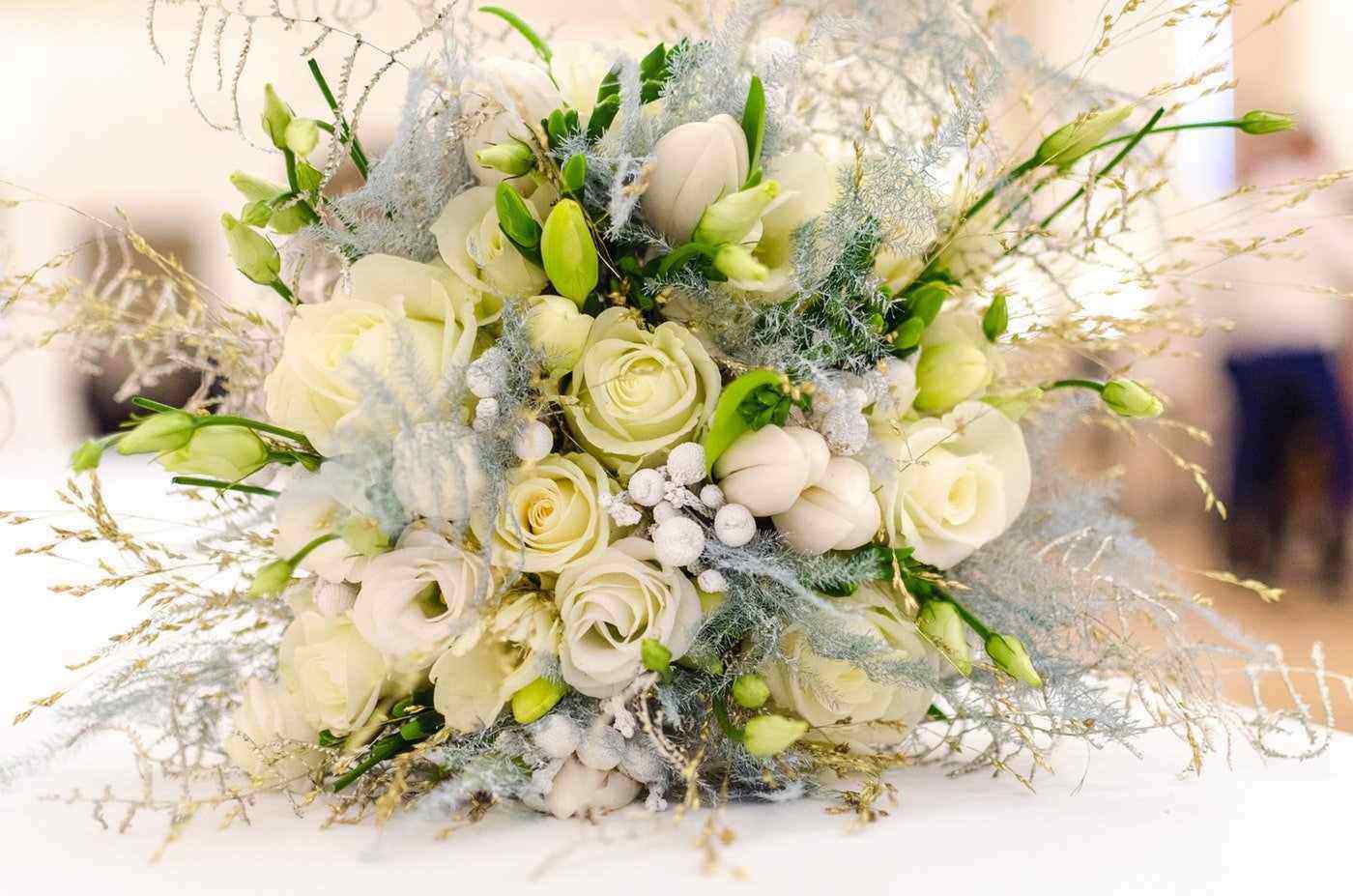If nothing else, organizing a wedding is an excellent exercise in trying not to feel overwhelmed when barrages of people ask you to make time-sensitive choices about things. If you are feeling overwhelmed, take a second and breathe deep. You’re doing a great job. I know it. You do still need to pick some flowers, though. If you’re completely at sea about what wedding flowers to get, try a quick check-in:
Imagine yourself at the perfect venue. What colors are around you? What textures are you looking at? What does everything smell like? How would you describe the atmosphere? Have your imaginary self do a 360 scan. What flowers do your partner and your wedding crew have on them? Look down. What flowers are you wearing or carrying?
Did any definite images come to you? Did any flowers stick out in your vision as being just the right ones? If so, that’s fantastic news! You’re well on your way to having “flowers” ticked off your to-do list. If everything seemed real hazy and indefinite, though, this guide might help. It offers some suggestions for everything from the centerpieces to the thank-you gifts.
Let’s start with the floral piece that’s going to be the most used and the most photographed – the bridal bouquet.
What Kind of Flowers to Get for Wedding Bouquets
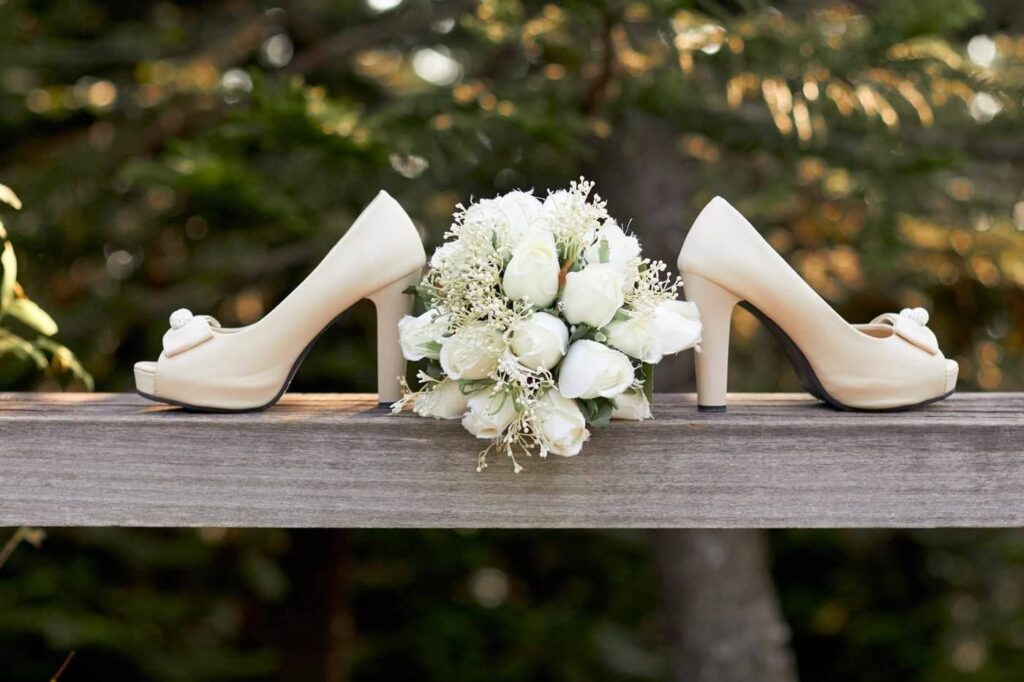
For many brides, the bridal bouquet is more than an accessory to that perfect dress. Bridal bouquets add drama and charm and its flowers make lovely keepsakes long after the big day is over.
As you know, the flowers you choose for your bouquet will depend on many factors such as season, cost, color and style. If you’re choosing wedding flowers in part based on their symbolic meanings, read up on color symbolism – many flowers have a range of traditional meanings depending on the color of the flower.
Ultimately, though, your bouquet should be an expression of your own personality and of the colors, smells and symbols you want to surround yourself with on that day. There are any number of wedding flowers you can choose from, but here are 10 of our favorites that we think are worth everybody’s consideration:
Baby’s Breath Bouquet
Gypsophila, or baby’s breath, is a perennial symbol of purity and innocence. Its tiny, delicate flowers have conventionally been limited to the role of filler for larger, showier blooms, but a baby’s breath bouquet has its own delicate charm. These flowers are often overlooked as focal points in a bridal bouquet, which makes them both original and also highly cost-effective.
Pairing gypsophila with other delicate white blooms such as jasmine, magnolia and gardenia can create lovely textured effects. For those looking for an interesting monochromatic clutch, or for something with a cascade to it, gypsophila is definitely worth a look.
Calla Lily Bouquet
These flowers are the height of simple elegance. They most commonly represent beauty, but also carry associations with purity and faith. There are two varieties that differ in size, so you could choose the large-headed, long-stemmed variety or the smaller, mini calla lily. Their stems are fairly flexible, and offer some creative options when constructing the bouquet.
The color possibilities are a bit limited with this flower. White and cream are the most common colors for bouquets, but these lilies also come in yellows, oranges and pinks. For a very bold, dramatic statement, consider dark purple calla lilies.
Dahlia Bouquet
Dahlias represent many things in many cultures, most commonly strength and grace. They’re a beautiful choice for a wedding flower – gorgeous but not too showy and complex without being distracting. Dahlias have a long growing season, so they’re more readily available and also less expensive than many other bridal flowers.
Dahlias are also incredibly versatile. There are hundreds of varieties in widely different sizes, colors and styles. Café au lait dahlias add gorgeous texture to bouquets. The more compact mignon dahlias make charming and understated nosegays. For some striking minimalism, focus your bouquet on a single dinner-plate dahlia.
Hydrangea Bouquet
Gorgeous and lush, hydrangeas carry a range of symbolic meanings with them. They’re associated with everything from sincerity, gratitude and abundance to vanity.
Their cultural significance might be ambiguous, but their practical advantages are not. Since stems of these flowers are so large and full, they can end up being a cost-effective choice since you’ll use far fewer of them.
With a smaller range of natural colors, all in the white or pastel family (specifically pink, blue, purple and green), these flowers have a light, springtime or summery aesthetic. If you’re looking for something a little different, green hydrangeas can make an uncommon and understated bridal bouquet, especially when combined with a range of complementary greenery.
Peony Bouquet
Peonies are beloved wedding flowers with head-turning beauty. They’ve long been associated with happy marriages, prosperity and love, which makes them a favorite with wedding parties. This gorgeous flower is more expensive and most readily available in late spring/early summer.
Their round shape adds a definitive curving profile to bridal bouquets, whether you’re using peonies as a standalone flower or pairing them with other blooms. White is, of course, the classic color but peonies come in bold and vibrant shades that lend dramatic contrast to bridal ensembles.
For even more impact, look into some double-flower varieties. Their layers add an extra softness and fullness to bouquets.
Ranunculus Bouquet
Delicate and vibrant, ranunculus is an immensely popular choice for wedding bouquets, especially smaller nosegays and clutches. Plus, it’s symbolic of charm and attraction, and who doesn’t want a little extra of that on their wedding day?
Ranunculus is a bit more cost-effective than other wedding flowers like peonies, which can be a huge plus for brides on a budget. It’s also widely grown and generally available throughout the year. Its wide range of colors make ranunculus an extremely versatile flower. Whether your style is classically romantic, soft, bright and cheerful or understated, ranunculus is a solid option.
Rose Bouquet
Roses are a classic choice. They’re iconic symbols of beauty, perfection and love at its peak. They have some more practical advantages, as well. There are thousands of varieties of roses and they come in a literal rainbow of colors, with some multi-colored and striped varieties available.
Since they’re so ubiquitous, roses are generally available in every season and they needn’t be expensive to be lovely. For a classic look, go with tea roses in your preferred color. For something more wild and romantic looking, consider spray roses. Remember that not every rose has a fragrance, so if you’re scent-sensitive, these flowers could still be an option for you.
Sunflower Bouquet
A sunflower bouquet adds a striking note of cheerfulness to a bridal ensemble. In addition to happiness, sunflowers represent good luck, long life, strong emotional bonds between people and the power of positive thinking.
Since they’re so large, many brides opt to use either a single large sunflower (or a few well-placed smaller sunflowers) in a mixed bouquet or to go with a bouquet that’s all sunflowers.
There are actually dozens of different varieties of sunflower, and many choices in size, style and color. Sunflowers are already a less common choice, but for something even more unique, explore some darker varieties. All are readily available in late summer and early autumn.
Tulip Bouquet
Tulips are lovely and elegant. Historically, they’ve been much prized and have symbolized beauty and the briefness of life. They’ll be most readily available in the spring and they carry a strong association with that season of new beginnings.
Their streamlined profiles make them an excellent option for more minimalist or contemporary weddings. They come in a huge range of colors, with pastel and vibrant palettes being the most popular.
If you like the idea of tulips but want something with a little more flair, look into parrot tulips. With their ruffles and bold colors, parrot tulips can be a more extravagant-looking variation on a tulip theme.
Wildflower Bouquets
Wildflowers give a wedding bouquet a, well, a wild look. They have their own bohemian, carefree aesthetic. No two are the same, which will necessarily mean your bouquet will be an original.
You have a whole world of varieties to choose from here, and since this bouquet will be eclectic, you can be free to mix, match, explore and experiment.
Daisies, black-eyed susans, cosmos, lupine, larkspur, goldenrod (for those without allergies!) – there are literally too many wildflowers to list. Selecting sustainably grown local wildflowers (or sustainably foraging your own) adds extra sentiment to this bouquet option.
What Kind of Flowers to Get for the Groom
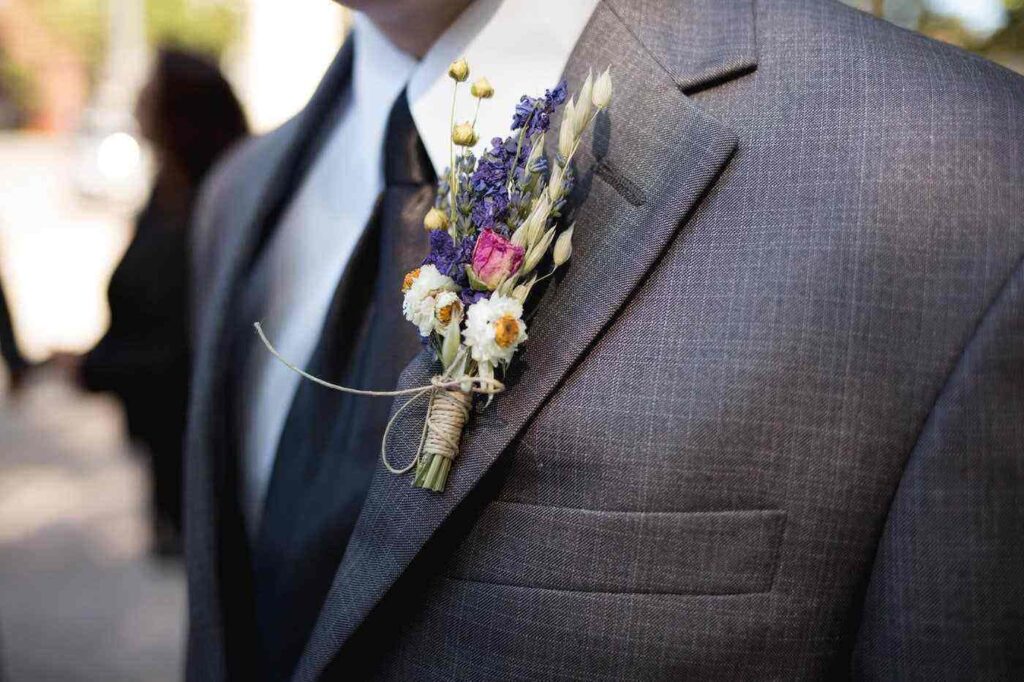
Grooms like flowers, too! The most common style choice is to either have the groom’s boutonniere match the bride’s bouquet or for the grooms to have matching boutonnieres.
If you’re going for a more spontaneous, eclectic look, or if the groom or grooms have specific flowers that they want to have with them on that day, making sure the flowers complement each other in shape, style or color will give a more seamless look.
Tulips make lovely boutonnieres, as do single orchids, calla lilies, ranunculus or gardenia. For sprigs of flowers, think about lily of the valley, jasmine, sea holly or spray roses. Some less traditional but no less beautiful options include thistles, succulents, greenery without flowers, hypericum berries or even herbs like bay leaves.
What Kind of Flowers to Get for Your Wedding Crew
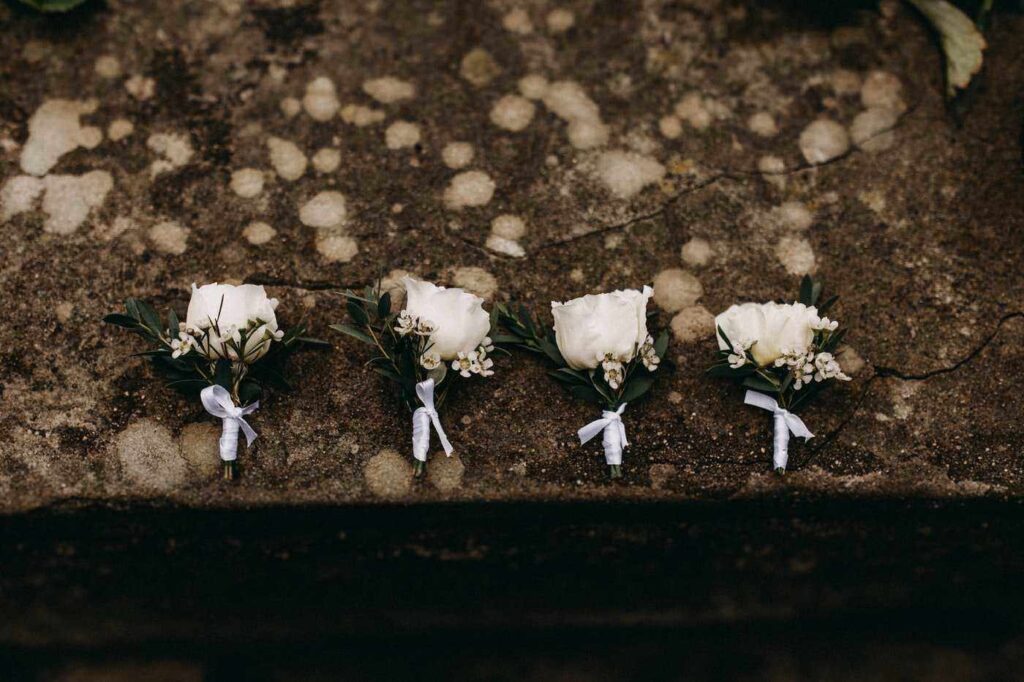
Whether you have a conventional wedding party of people who identify as women waiting on a bride and people who identify as men waiting on a groom, or whether you have a more gender-diverse crew playing different roles, your crew will also need some flowers.
What Kind of Flowers to Get for Your Bridesmaids
The kinds of flowers the bridesmaids carry should depend on the flowers the bride carries. Traditionally, whoever is serving as a bridesmaid carries smaller versions of the bouquet the bride is carrying. Fortunately (or not, depending on your taste), more creative options are becoming mainstream.
Having the bridal party carry bouquets that complement or even contrast the bride’s flowers can be a simple way to highlight the unique beauty of each bouquet and each person carrying it.
Bridesmaids needn’t carry flowers at all – sprigs of evergreen, lush grasses, succulents or bouquets of foliage with large, glossy leaves can make a lovely contrast when paired with a more classic bridal bouquet.
What Kind of Flowers to Get for Your Groomsmen
Groomsmen traditionally wear boutonnieres that are slightly different (and usually slightly smaller) than the boutonniere the groom is wearing. Just like bridal party bouquets, it’s becoming more and more mainstream to have each boutonniere complement the others, rather than having everything match exactly.
It’s easy to find variations on classic boutonniere flowers like roses or ranunculus if you want to have each person on the groom’s side wear flowers that differ only slightly.
If you want a more high-contrast look, each person in the groom’s party could wear a different type of succulent or a different type and color of orchid. It’s really all about your preferences.
What Kind of Flowers to Get for Your Flower Girl
Given this title, it’s not surprising that there are a number of different ways to incorporate flowers into this role. You might choose to have this child wear a crown of flowers. Daisies, buttercups, lavender, gypsophila, roses or peonies are lovely flowers for a crown.
Your flower girl could carry a smaller bouquet or a single flower that matches what the grownups are carrying. They could also carry a basket of petals to scatter. Typically rose petals are used for this but you might also think about scattering wildflowers, leaves or small flowers such as chamomile, or hydrangea or delphinium florets.
What Kind of Flowers to Get for Your Ring Bearer
The ring bearer often wears a small boutonniere, but they can also carry flowers. You might choose to incorporate flowers in and around the ring box itself. Stick with simple designs for a boutonniere if that’s the route you go.
Flowers can be pinned to a small pillow or glued to a box lid so you and your ring bearer don’t have to worry about them flying off in the event of a careless step. Peonies, hydrangea, sunflowers, marigold, dahlias, zinnias or any other sturdier flower is best in this role.
What Kind of Wedding Flowers to Get for Your Venue
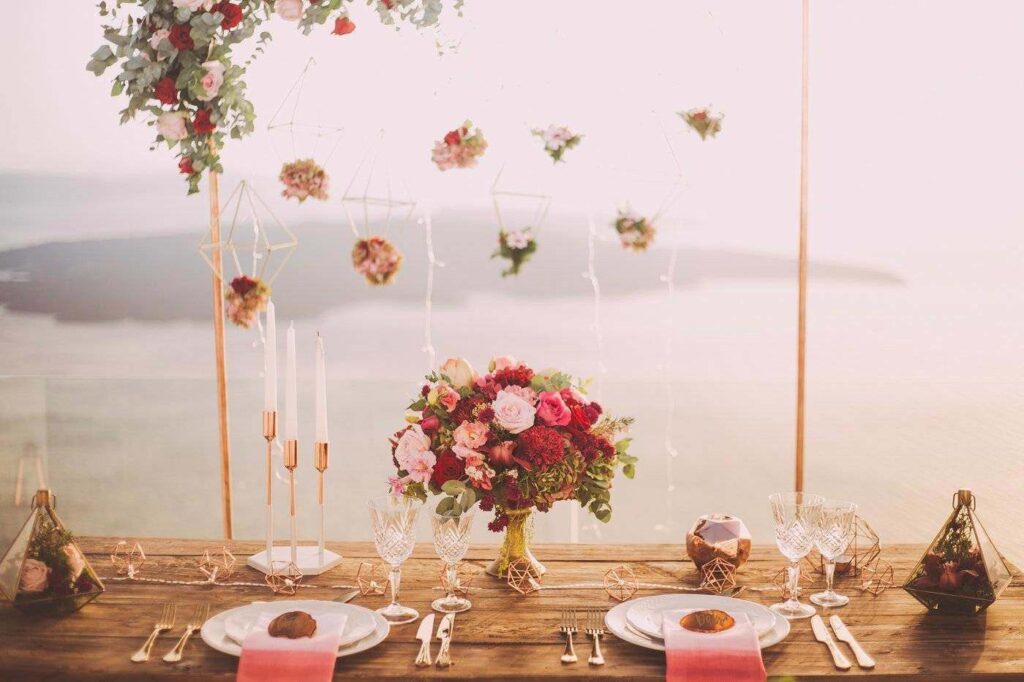
Your venue is where flowers can make the biggest design impact. The right wedding flowers can make any ordinary room special and they can turn a beautiful venue into a paradise. Modern weddings tend to feature simpler arrangements that focus on one or two flowers and that highlight their gorgeous greenery. They also tend towards the eclectic, so that not every table in the venue looks the same.
Your florist or wedding designer will be invaluable in orchestrating the venue’s overall floral aesthetics. They’ll help you to wade through choices involving color, style, cost and season, as well as the aesthetics and the logistics of the venue itself. In the end, though, your choices will be about the atmosphere you want to create. Do you want something loose and informal? Romantic? Classically elegant? Dramatic? Modern? Bohemian chic? Here are some suggestions to help you craft your vision of the perfect space.
What Type of Flowers to Get for Wedding Centerpieces
For a stately and modern look, consider tall, sleek vases filled with large calla lilies. Tall arrangements that cascade (such as jasmine, lavender or sweet peas) are elegant but a bit more on the romantic side. Going for a more earthy look? Wreaths of wildflowers around low candles will beautifully fill out a table and are especially lovely for fall weddings.
Wreaths of evergreens are perfect for winter. You can also create full, gorgeous swags with them. A lush runner of greens studded with roses and fairy lights gives an opulence to a long head table.
Consider creating a water feature on your tables with a simple rose bowl and a waterlily. Or go very eclectic by grouping a number of small, complementary pots with succulents. Guests can each take one home as a thank-you gift.
Read more on this topic in 5 Tips for Creating the Perfect Wedding Centerpiece.
What Flowers Work Best as Aisle Décor
These are wedding flower arrangements at their most functional. In addition to considering the colors and shapes of your blooms, you’ll need to ensure your arrangements are highly visible (for guests who might be vision-impaired) and sturdy.
Pedestal vases work well if you need to bring more definition and substance to the ends of your aisles. Very tall flowers like sunflowers or greenery like pampas grass also work to define a space, but they should be in clearly visible containers that are heavy enough not to tip. Large pots of ferns, or even small trees, lend a more natural look to any space.
Smaller arrangements can be tied to the end chairs, or the ends of pews or benches themselves. If you choose a full, cascading arrangement, the containers needn’t even be fancy because no one will see them.
What Flowers to Get for a Flower Arch
If you’re incorporating a flower arch (or any other big floral piece) into your decor, cost will almost definitely be a big factor in your design choices. A full arch decked out with show-stopping roses and peonies will set you back a fair bit.
Flower arches needn’t be prohibitively expensive, though. An arch made of wood or branches trimmed with a few high-impact blooms like peonies, lilacs or branches of apple blossoms can create a stunning effect. Likewise, arches that focus on draping greenery and use spots of color for highlights (think dahlias, gerberas, anemone, clematis or scabiosa) can give a lush, full effect without a big price tag.
There are many smaller locations in your venue that you could decorate with flowers, as well. The cake table, welcome table, card and gift tables, to name a few, can all be included in your floral theme. Re-using the wedding flowers from the ceremony in these lower-impact spaces can be a great way to stretch your budget and contribute to the overall effect.
What Type of Flowers to Use as Thank-you Gifts
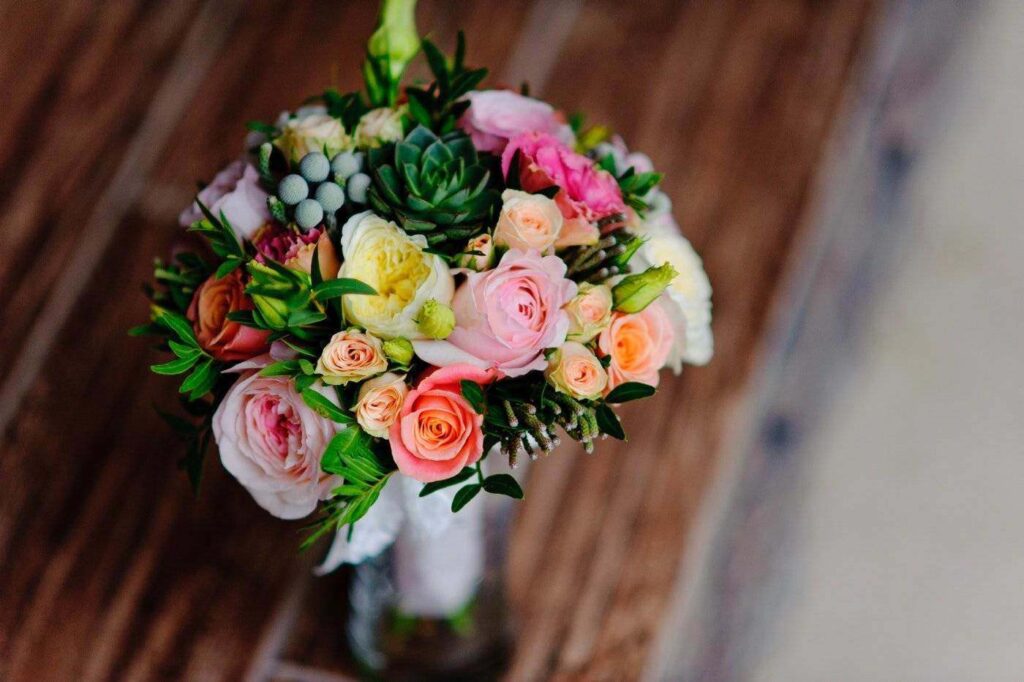
You’ll be sending thank-you notes, of course, to your guests and to anyone who provided a service for you, but some people go above and beyond. Parents, your wedding crew, people who hosted parties for you, friends who took on extra labour like cooking or decorating – they all deserve a special gesture of thanks. There’s no better way to say thank-you to the people who helped and supported you most than by sending them flowers.
If you know what someone’s favorite flowers are, send those – it’s an extra nice way to show someone your gratitude. Bouquets of sweet peas, daisies, asters or irises make wonderful thank-you gifts, but any flowers that are bright and cheery are a good choice here.
We hope this helped give you some inspiration for your wedding flowers. As your wedding planning forges ahead, remember to breathe deep, stretch regularly, drink plenty of water and enjoy every minute of it.
feature image: Lukas; image 1: Ihsan Aditya; image 2: Pixabay; image 3: Fidel Hajj; image 4: Edward Eyer; image 5: Anton Mislawsky
